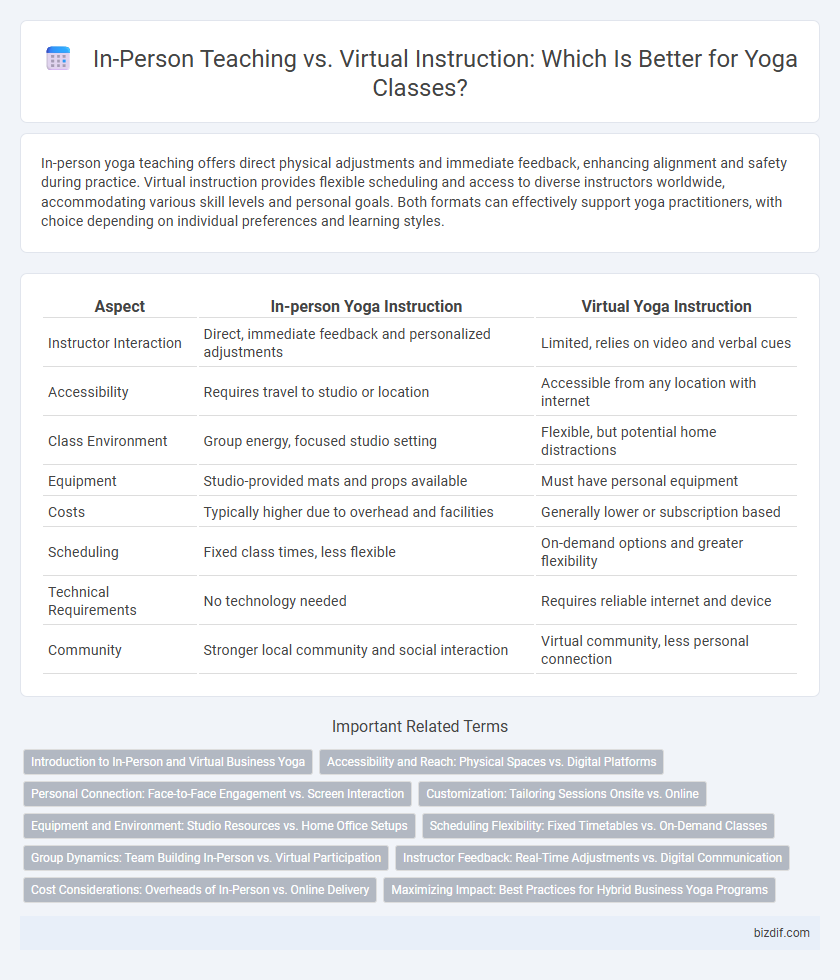In-person yoga teaching offers direct physical adjustments and immediate feedback, enhancing alignment and safety during practice. Virtual instruction provides flexible scheduling and access to diverse instructors worldwide, accommodating various skill levels and personal goals. Both formats can effectively support yoga practitioners, with choice depending on individual preferences and learning styles.
Table of Comparison
| Aspect | In-person Yoga Instruction | Virtual Yoga Instruction |
|---|---|---|
| Instructor Interaction | Direct, immediate feedback and personalized adjustments | Limited, relies on video and verbal cues |
| Accessibility | Requires travel to studio or location | Accessible from any location with internet |
| Class Environment | Group energy, focused studio setting | Flexible, but potential home distractions |
| Equipment | Studio-provided mats and props available | Must have personal equipment |
| Costs | Typically higher due to overhead and facilities | Generally lower or subscription based |
| Scheduling | Fixed class times, less flexible | On-demand options and greater flexibility |
| Technical Requirements | No technology needed | Requires reliable internet and device |
| Community | Stronger local community and social interaction | Virtual community, less personal connection |
Introduction to In-Person and Virtual Business Yoga
In-person business yoga classes offer hands-on adjustments and immediate feedback, enhancing alignment and posture correction for improved participant outcomes. Virtual instruction provides flexibility and accessibility, enabling employees to join sessions from various locations while maintaining consistent engagement through live or recorded content. Both formats support workplace wellness by reducing stress and promoting mindfulness, though the choice depends on company culture and logistical considerations.
Accessibility and Reach: Physical Spaces vs. Digital Platforms
In-person yoga instruction offers tangible benefits like hands-on adjustments and a dedicated space fostering a strong sense of community, yet it is limited by geographical constraints and class size. Virtual yoga instruction maximizes accessibility by enabling practitioners worldwide to join sessions anytime, overcoming physical and scheduling barriers. Digital platforms broaden reach significantly, allowing instructors to scale their teachings and connect with diverse audiences beyond local boundaries.
Personal Connection: Face-to-Face Engagement vs. Screen Interaction
In-person yoga instruction fosters deeper personal connection through direct eye contact, physical adjustments, and real-time energy exchange, enhancing student alignment and motivation. Virtual instruction relies on screen interaction, which can limit the instructor's ability to fully observe subtle body cues and deliver immediate tactile guidance. While virtual classes offer convenience, the absence of face-to-face engagement may reduce the sense of community and personalized support crucial for effective yoga practice.
Customization: Tailoring Sessions Onsite vs. Online
In-person yoga instruction allows for real-time adjustments based on physical cues and immediate feedback, enhancing session customization to individual body alignment and flexibility. Virtual instruction utilizes digital tools such as video analysis and personalized progress tracking, enabling tailored guidance despite physical distance. Both formats offer unique customization benefits, with in-person sessions excelling in hands-on corrections and virtual classes providing flexible, data-driven adaptations.
Equipment and Environment: Studio Resources vs. Home Office Setups
In-person yoga instruction benefits from specialized studio resources such as professional mats, props, and controlled ambiance that enhance posture alignment and focus. Virtual instruction relies on home office setups where space constraints and limited equipment might affect practice quality and instructor adjustments. Optimal virtual sessions leverage accessible tools like yoga blocks and straps, alongside well-lit, quiet environments to mimic studio conditions.
Scheduling Flexibility: Fixed Timetables vs. On-Demand Classes
In-person yoga teaching typically follows fixed timetables, requiring students to align their schedules with predetermined class times. Virtual instruction offers on-demand classes that provide greater scheduling flexibility, enabling practitioners to access sessions anytime according to personal convenience. This adaptability often leads to higher engagement and consistency in practice among virtual learners.
Group Dynamics: Team Building In-Person vs. Virtual Participation
In-person yoga instruction fosters stronger group dynamics through physical presence, enabling real-time adjustments, immediate feedback, and shared energy that enhance team building. Virtual participation relies on digital interaction, which may limit non-verbal cues and spontaneous group bonding but allows accessibility and inclusivity across distances. Effective group cohesion in virtual settings depends on interactive tools and intentional facilitation to replicate in-person social connections.
Instructor Feedback: Real-Time Adjustments vs. Digital Communication
In-person yoga instruction enables instructors to provide real-time adjustments through hands-on guidance and immediate verbal cues, enhancing posture accuracy and reducing injury risks. Virtual yoga classes rely on digital communication tools like video calls and chat, which can limit the instructor's ability to correct subtle alignment issues promptly. The effectiveness of feedback in virtual settings depends heavily on the instructor's observation skills and the technology's quality, potentially impacting overall practice outcomes.
Cost Considerations: Overheads of In-Person vs. Online Delivery
In-person yoga instruction incurs higher overhead costs including studio rent, utilities, and equipment maintenance, which often leads to increased class fees for students. Virtual instruction significantly reduces these expenses by eliminating physical space requirements and minimizing material costs, allowing instructors to offer more competitive pricing. However, investment in reliable technology and digital platforms is essential to maintain quality and engagement in online sessions.
Maximizing Impact: Best Practices for Hybrid Business Yoga Programs
In-person yoga instruction allows for personalized alignment adjustments and real-time energy exchange, enhancing student engagement and retention. Virtual classes provide flexibility and expanded reach, enabling instructors to connect with diverse audiences globally and offer on-demand content. Combining both modalities in a hybrid yoga program maximizes impact by blending tactile feedback with scalable accessibility, supported by best practices such as interactive technology, consistent scheduling, and community-building strategies.
In-person teaching vs Virtual instruction Infographic

 bizdif.com
bizdif.com